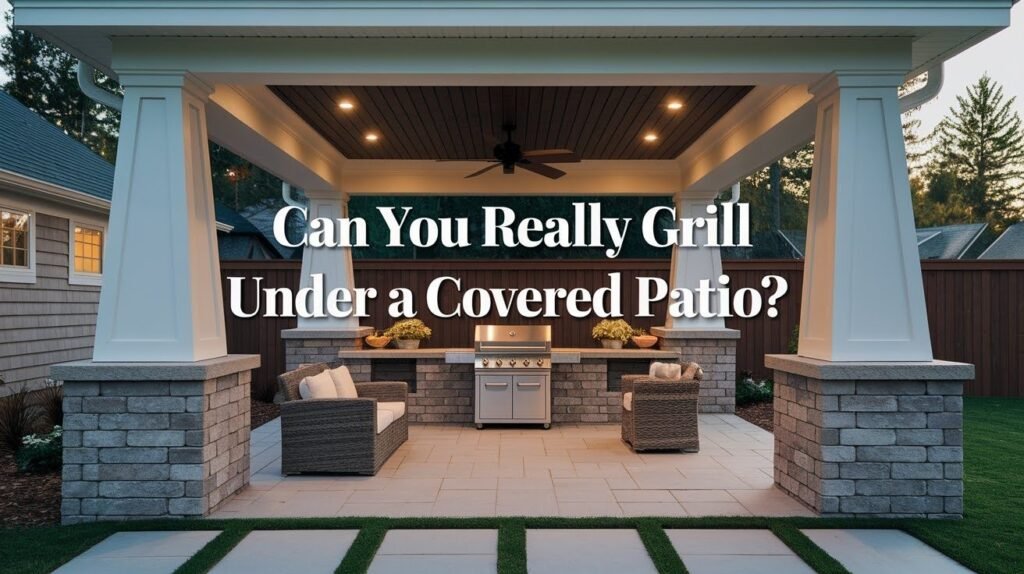Grilling under a covered patio offers the perfect solution for year-round outdoor cooking, protecting you from rain, intense sun, and unpredictable weather while maintaining that authentic barbecue experience.
However, before firing up your grill in this convenient setup, it’s crucial to understand the safety implications and proper procedures involved.
This comprehensive guide addresses the essential question of safe patio grilling by covering critical safety considerations, proper ventilation requirements, suitable grill types for covered spaces, and practical setup tips.
We’ll help you determine if your covered patio can accommodate safe grilling while ensuring you protect your family, property, and investment.
With the right knowledge and precautions, you can enjoy delicious grilled meals regardless of weather conditions.
Is It Safe to Grill Under a Covered Patio?
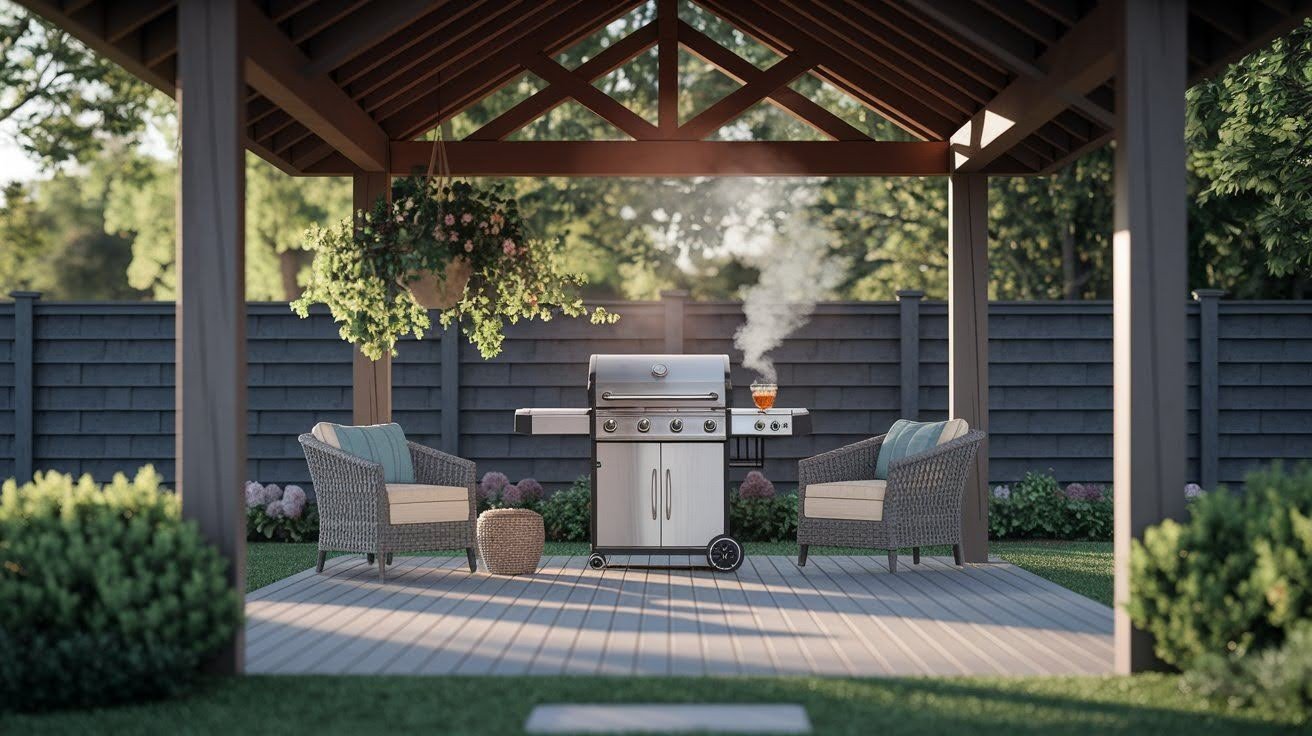
Grilling under cover requires careful attention to fire hazards, proper ventilation, smoke damage prevention, and carbon monoxide safety considerations.
Potential Fire Hazards
Grilling under a covered patio presents significant fire risks that require careful consideration.
The combination of intense heat, open flames, and nearby flammable materials creates a potentially dangerous situation.
Wood structures, fabric furniture, hanging plants, and decorative elements can easily ignite when exposed to high temperatures or sparks from your grill.
Overhanging ceilings pose particular concerns, as they can trap heat and create fire hazards.
Low-hanging rooflines, exposed wooden beams, and combustible ceiling materials like certain types of wood paneling or synthetic materials can catch fire when exposed to excessive heat.
Even seemingly safe distances can become problematic when wind conditions change or when grease fires occur unexpectedly.
Smoke and Gas Concerns
Proper ventilation becomes critical when grilling in enclosed or semi-enclosed spaces. Both gas and charcoal grills produce carbon monoxide, an odorless, colorless gas that can be deadly in confined areas.
Without adequate airflow, this dangerous gas can accumulate to harmful levels, posing serious health risks to you and your family.
Smoke damage presents another significant concern for covered patio grilling. Continuous exposure to smoke can stain ceiling materials, discolor painted surfaces, and leave persistent odors in fabric furniture and cushions.
Additionally, grease and smoke residue can damage patio screens, light fixtures, and other permanent installations, leading to costly repairs or replacements.
What Kind of Grills Are Safe for Covered Patios?
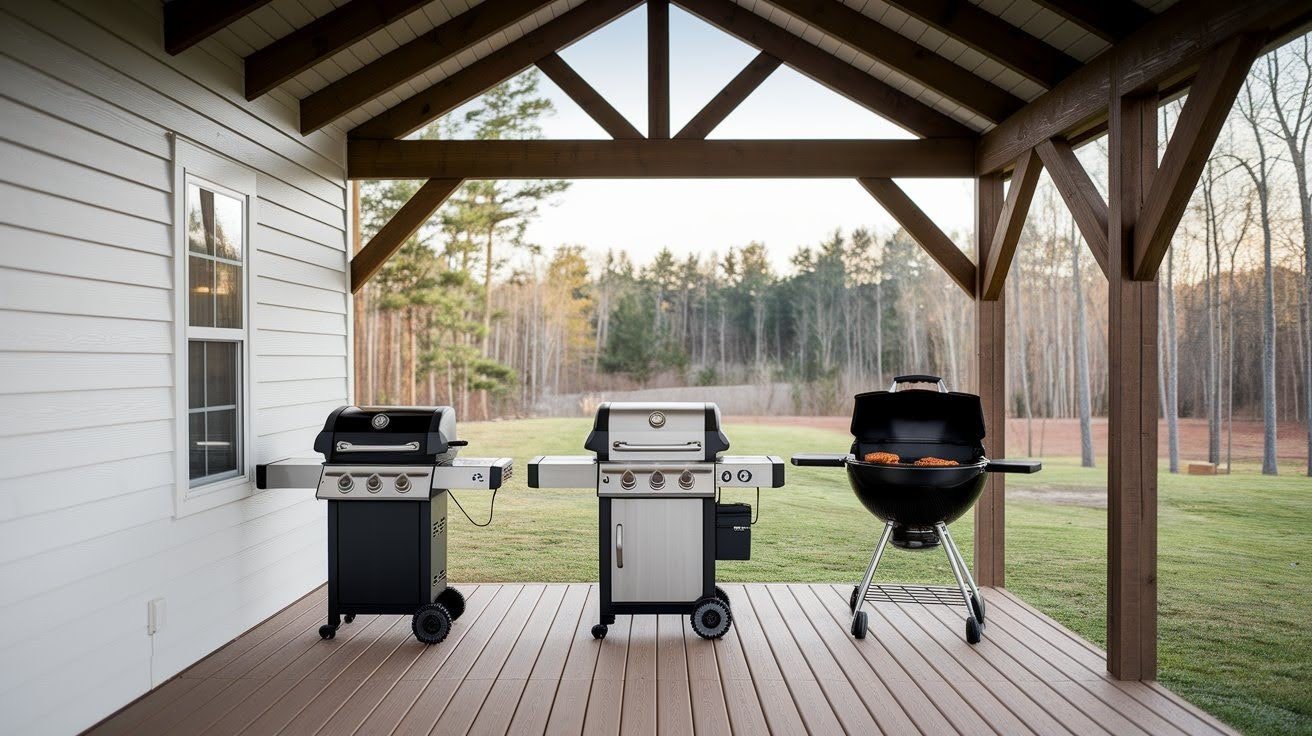
Electric grills offer safest covered patio cooking, gas grills need caution and ventilation, charcoal grills aren’t recommended for enclosed spaces.
1. Electric Grills – The Safest Bet
Electric grills represent the safest option for covered patio cooking, offering significant advantages over traditional fuel-powered alternatives.
With no open flames or combustible fuel sources, electric grills eliminate many fire hazards associated with covered outdoor cooking.
They produce minimal fumes and smoke, making them ideal for enclosed or semi-enclosed patio spaces where ventilation might be limited.
These grills operate at lower temperatures than gas or charcoal options, reducing heat-related risks to overhead structures and nearby materials.
While they may not provide the same smoky flavor as traditional grills, electric models offer consistent cooking results with easy temperature control and minimal maintenance requirements.
2. Gas Grills – Use With Caution
Gas grills remain a popular choice for covered patios but require careful placement and strong ventilation systems.
These grills produce cleaner combustion than charcoal but still generate heat, moisture, and some combustion byproducts that need proper airflow management.
Position gas grills well away from walls, ceilings, and any combustible materials to prevent heat damage and fire hazards.
Ensure adequate clearance on all sides, typically at least three feet from walls and ten feet from overhead structures.
Regular maintenance of gas connections, proper tank storage, and installation of ventilation fans can help make gas grilling safer under covered areas.
3. Charcoal Grills – Not Recommended
Charcoal grills are generally not recommended for covered patio use due to their high smoke production and carbon monoxide output.
These grills create significantly more smoke than gas or electric alternatives, leading to poor air quality and potential health hazards in enclosed spaces.
The intense heat and unpredictable flame patterns make them unsuitable for areas with overhead protection.
Charcoal grills perform best in completely open-air environments where smoke and heat can dissipate naturally. For the safest outdoor cooking experience, reserve charcoal grilling for open yards or uncovered deck areas.
Why Ventilation Is Non-Negotiable
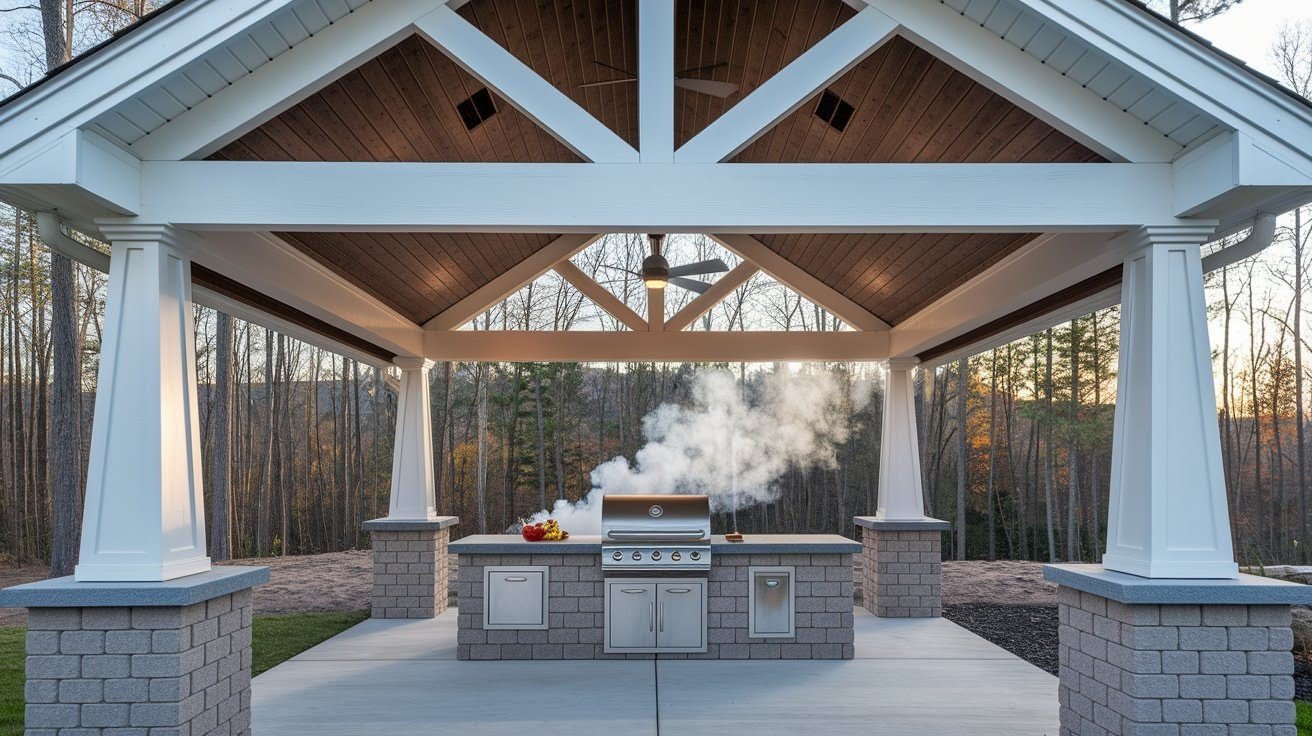
Proper airflow prevents smoke accumulation, carbon monoxide poisoning, and heat damage while ensuring safe grilling conditions under covered patios.
The Dangers of Poor Airflow
Poor ventilation creates serious health and safety risks that make proper airflow absolutely essential for covered patio grilling.
Smoke accumulation in enclosed spaces can cause respiratory irritation, eye problems, and long-term health issues, particularly for individuals with asthma or other breathing conditions.
Without adequate air circulation, smoke particles and cooking fumes become trapped, creating an uncomfortable and potentially harmful environment.
Trapped heat presents another significant danger, as it can damage overhead structures, warp materials, and create fire hazards.
Most critically, inadequate ventilation allows carbon monoxide to accumulate to dangerous levels.
This deadly gas can cause headaches, dizziness, nausea, and in severe cases, unconsciousness or death.
Even brief exposure to high concentrations can be life-threatening, making proper ventilation a non-negotiable safety requirement.
How to Improve Ventilation
Effective ventilation requires multiple strategies working together to create proper airflow patterns.
Keep at least two sides of your covered patio completely open to allow natural air circulation and cross-ventilation.
Install roof vents or ridge vents to allow hot air and smoke to escape upward, while ceiling fans help move air horizontally and prevent stagnant pockets from forming.
For more comprehensive solutions, consider installing outdoor exhaust systems specifically designed for covered cooking areas.
Adjustable louvers provide flexible ventilation control, allowing you to regulate airflow based on weather conditions and cooking requirements.
Position these ventilation elements strategically to create a continuous flow of fresh air while effectively removing smoke, heat, and combustion byproducts from your covered patio space.
How Your Patio Materials Affect Grilling Safety
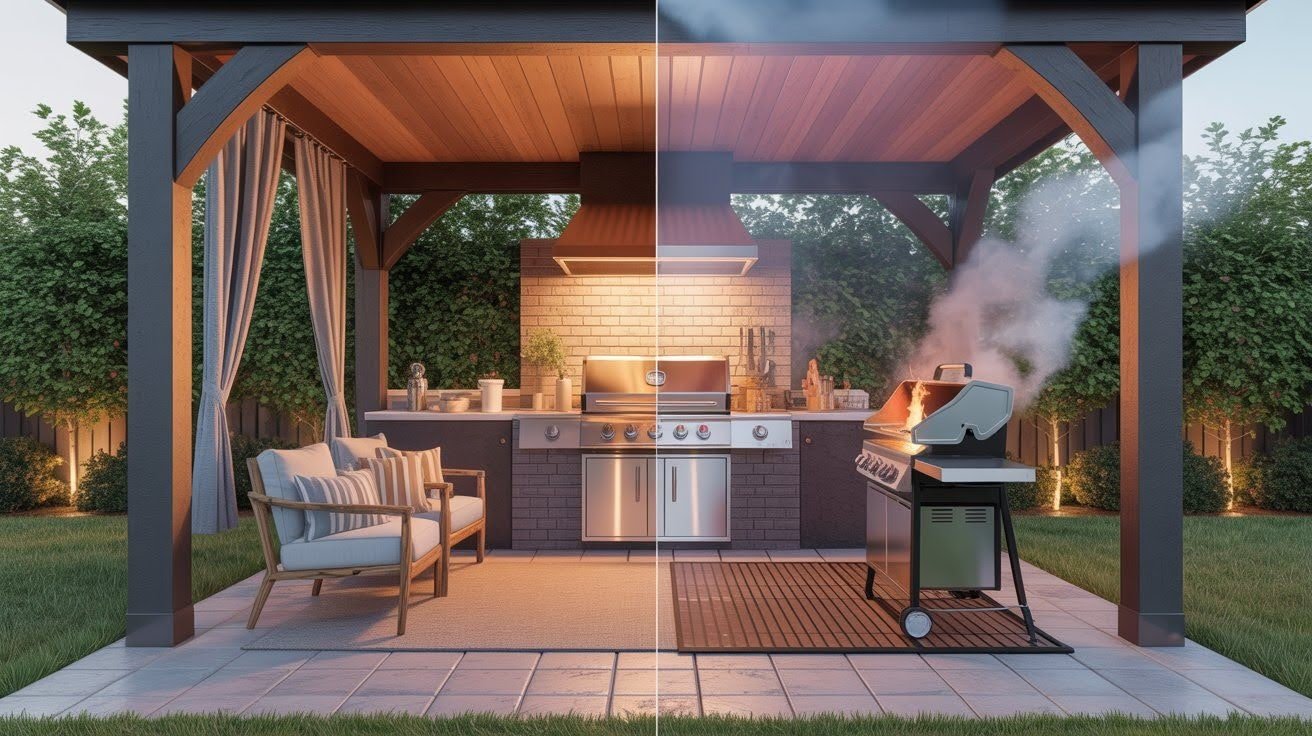
Wood, vinyl, and fabric materials create fire risks while stone, tile, and aluminum provide safer, heat-resistant alternatives for grilling.
Heat- and Smoke-Sensitive Materials
The materials used in your covered patio construction significantly impact grilling safety and should be carefully evaluated before setting up any cooking equipment. Wood ceilings pose particular risks as they can warp, discolor, or even ignite when exposed to high temperatures and repeated heat cycles. Cedar, pine, and other softwoods are especially vulnerable to heat damage and can develop cracks or splits that compromise structural integrity.
Vinyl siding presents another concern, as it can melt, warp, or release toxic fumes when exposed to excessive heat from grilling. Fabric elements like outdoor curtains, cushions, and umbrellas are highly flammable and can ignite quickly from sparks or radiant heat. Even synthetic materials marketed as “outdoor-friendly” may not withstand the intense heat generated by grilling equipment, making their placement near cooking areas potentially dangerous.
Safer Alternatives
Creating a safer grilling environment requires selecting materials that can withstand heat and resist fire damage. Install fire-resistant barriers like cement board or metal sheeting between your grill and vulnerable surfaces to protect wood structures and siding. Stone or tile surfaces provide excellent heat resistance for flooring and can handle dropped coals or grease spills without sustaining damage.
Aluminum framing offers superior heat resistance compared to wood construction and won’t warp or deteriorate under high temperatures. Use heat-resistant mats specifically designed for outdoor grilling to protect your patio floor from heat damage, grease stains, and potential fire hazards. These protective measures create a buffer zone that allows you to grill safely while preserving your patio’s appearance and structural integrity.
Smart Setup Tips for a Covered Patio Grill Station
Create safe, functional grilling spaces with proper clearance, useful features, and essential safety equipment for covered patio cooking success.
Maintain Proper Clearance
- Keep your grill at least three feet away from walls, railings, and vertical surfaces to prevent heat damage and reduce fire risks while allowing proper air circulation.
- Maintain a minimum of ten feet of clearance from overhead structures like ceilings, beams, or hanging decorations to allow heat dissipation and prevent ignition.
- Remove or relocate plastic furniture, fabric cushions, and flammable items from the immediate grilling area to create a designated safety zone around your equipment.
Add Useful Features
- Install adequate lighting for nighttime grilling using LED strip lights or weather-resistant spotlights to clearly see food, controls, and surrounding areas safely.
- Incorporate storage solutions like stainless steel racks, heat-resistant drawers, or hanging organizers for grilling utensils positioned safely away from direct heat sources.
- Consider adding a prep counter or heat-resistant side table to provide convenient workspace for food preparation and plating during cooking sessions.
Include Safety Essentials
- Keep a Class B fire extinguisher specifically designed for grease fires within easy reach and ensure all family members know its location and operation.
- Establish a strict rule to never leave your grill unattended while in operation, with a designated person responsible for monitoring at all times.
- Keep a spray bottle filled with water nearby for minor flare-ups and maintain clear escape routes from your cooking area for emergency situations.
Conclusion
Grilling under a covered patio can be both safe and enjoyable when approached with the right knowledge and precautions.
Throughout my years of outdoor cooking, I’ve learned that success comes down to three key factors: choosing the appropriate grill type, ensuring proper ventilation, and maintaining adequate clearances from combustible materials.
Electric grills offer the safest option for covered spaces, while gas grills require careful planning and ventilation systems.
Remember that your patio materials play a crucial role in safety – invest in heat-resistant surfaces and fire-resistant barriers where needed.
Most importantly, never compromise on safety essentials like fire extinguishers and constant supervision.
With proper setup and attention to these guidelines, you can enjoy delicious grilled meals year-round while keeping your family and property safe. Happy grilling!
Frequently Asked Questions
Is it safe to grill under a covered patio?
Yes, it can be safe with proper precautions including adequate ventilation, appropriate grill selection, and maintaining proper clearances. Electric grills are safest, while gas grills require careful placement and strong airflow systems.
What type of grill works best for covered patio cooking?
Electric grills are the safest option as they produce no open flames and minimal smoke. Gas grills can work with proper ventilation, but charcoal grills aren’t recommended due to excessive smoke and carbon monoxide production.
How much clearance do I need around my grill?
Maintain at least 3 feet of clearance from walls and railings, and 10 feet from overhead structures. Remove flammable materials like plastic furniture and fabric cushions from the immediate grilling area.
What ventilation requirements are needed for covered patio grilling?
Keep at least two sides of your patio completely open for cross-ventilation and install roof vents or ceiling fans. Consider outdoor exhaust systems or adjustable louvers for better airflow control and smoke removal.
What safety equipment should I have when grilling under cover?
Keep a Class B fire extinguisher designed for grease fires within easy reach of your cooking area. Never leave the grill unattended and maintain a spray bottle with water nearby for minor flare-ups.


